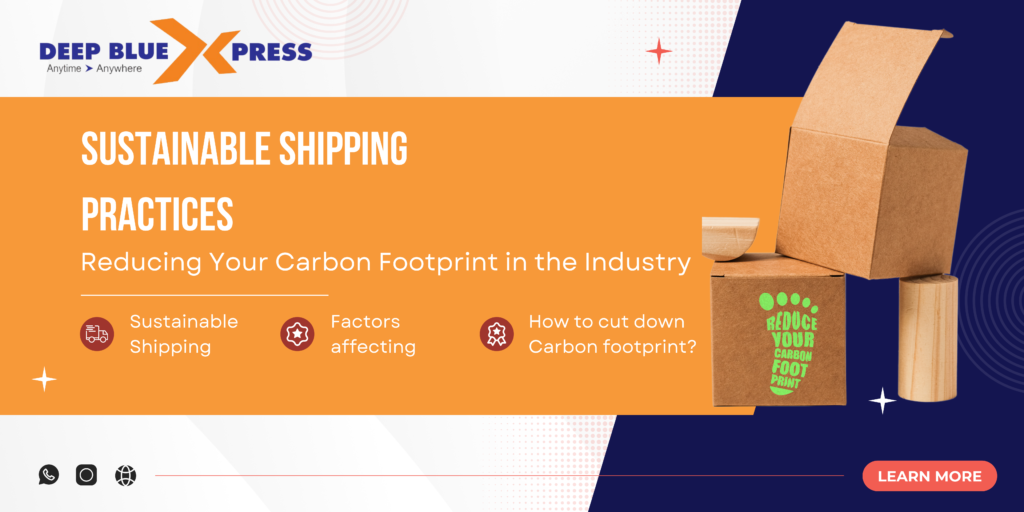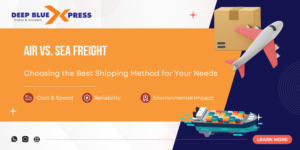The phrase “sustainability” has recently gained popularity in the corporate community. The goal is to support businesses for the long run without endangering the environment. Since industrialization has progressively harmed the world, the business sector is right to demand for this endeavour.
The environmental impact of the global shipping industry has come under increased criticism in recent years. Businesses in the maritime industry are under pressure to implement sustainable practices that reduce their carbon footprint as worries about climate change intensify. At Deep Blue Xpress Limited, we are dedicated to integrating environmentally friendly solutions into every aspect of our business because we understand how important it is to tackle these issues head-on.
This also applies to the e-commerce sector. The industry needs to use sustainable methods to lessen its carbon footprint because it is a contributor to carbon emissions. 13% of the greenhouse gas (GHG) emissions in e-commerce come from transport-related sources alone. Your company’s carbon footprint can be significantly decreased by implementing sustainable shipping procedures.
What Is Sustainable Shipping?
Using environmentally friendly practices in the shipping sector is known as sustainable shipping. This mostly refers to delivery-related shipping and transportation within e-commerce, although environmental impact of end-to-end shipments should also be taken into account by overall sustainable business practices.
More than carbon emissions are included in the environmental impact of the worldwide shipping and transportation sectors. That needs to consider
- how long-lasting shipping containers are
- supplies of international merchant fleets
- usage of fossil fuels
- the impact on other ecosystems, including the maritime environment
Why Does Sustainable Shipping Matter?
Not only do customers prefer to do business with sustainable companies, but 86% of individuals also choose to work for sustainable companies. Sustainable shipping practices are a good area for firms to start because the transportation and shipping industries have large environmental footprints, particularly in terms of greenhouse gas emissions.
38% of the energy-related carbon emissions in the US in 2021- a total of 1.7 billion metric tons-came from the transportation sector. 80% of all commodities moved worldwide are shipped by water, therefore although maritime transportation has a less impact than air freight, it still has a significant one. Despite contributing approximately 2% to 3% of the world’s carbon dioxide emissions, maritime transport has a significant impact in other sectors as well.
These include:
- Chemical and oil spills
- Pollution resulting from missing shipping containers
- collisions with sea life
- noise pollution
- harm to marine organisms
- and social factors, such as how it will affect coastal populations’ means of living.
How to Cut Down on Carbon Footprint in E-Commerce Transport and Delivery?
The world population has suddenly increased in recent years, which has increased demand for products and services as well as energy usage. As a result, businesses have been generating more, and the economy has expanded quickly, both of which have increased the carbon footprint overall.
The data is unambiguous: over the past 30 years, there has been a 60% increase in global carbon emissions, according to Statista. 37.12 billion metric tonnes (GtCO₂) of these emissions were produced globally in 2021, and 37.5 GtCO₂ in 2022.
E-commerce is one of the sectors that most significantly increases carbon emissions worldwide. The epidemic has further triggered an exponential boom in this industry:
Precedence Research projects that the global e-commerce market would reach $57.22 trillion by 2032, up from $18.71 trillion in 2024. It is anticipated to increase at a 15% compound annual growth rate (CAGR).
Source: Precedence Research projects
Online companies have been selling goods and services due to the rapid expansion of the market, significantly increasing their carbon footprint. Additionally, we can blame their modes of transportation—trucking or shipping—for their contributions to carbon emissions.
This raises the issue, though: What can you do to lessen your carbon impact, particularly in the case of trucking and shipping for e-commerce? Observe and put into practice the following best practices.
- Make use of recyclable packing materials:
An essential component of the entire e-commerce equation is proper packaging. You may improve the shipping and trucking of your products by using effective and efficient procedures. Poor packaging, on the other hand, can result in wasteful product usage, inefficient transportation, and a significant carbon footprint.
As a result, by following the guidelines below, you can optimise your packaging for online sales.
- Tailor packaging to cut down on waste and space.
- When packing, use reusable and environmentally friendly materials.
- Purchase reusable packing supplies.
- Use bulk packing by combining several things into one container.
- Use the appropriate barcoding and labelling.
- Collaborate with Environmental Organisations:
It is best to collaborate with leading organisations that support corporate sustainability and environmental preservation. They may assist you in creating and putting into effect sustainable strategies that will lessen your online business’ carbon footprint. Acquiring standard certifications is also necessary for a company to have a good reputation, to ensure client loyalty, and to boost profitability.
You can collaborate with the following governmental and non-governmental organisations:
- The independent International Organisation for Standardisation (ISO) establishes global standards for a range of industries. In addition to environmental responsibility, ISO standards aim to ensure process efficiency, product quality, and safety.
- The multinational organisation Greenpeace is well-known for its activism in support of environmental protection and conservation. The organisation focuses its campaigns on environmental protection, reducing carbon emissions, and climate change.
- Get Eco-Friendly Motor vehicles
Transportation for e-commerce adds a lot to carbon emissions. For transportation, delivery cars, trucks and cargo ships burn a lot of fossil fuels, which releases a lot of carbon dioxide into the atmosphere. It’s time to hunt for other ways to go around.
According to Forrester, five Fortune Global 200 companies will announce travel plans that prioritise sustainability. The most beneficial plan of action, though, would be to purchase environmentally friendly cars. Ward suggests making the following investments.
- Electric vehicles run on electricity that is stored in rechargeable batteries. Compared to cars that run on petrol and diesel, these are superior options.
- Short-distance cargo bikes are powered by humans or an electric motor to carry goods or objects. Consider the cargo trikes and motorcycles that are utilised in your neighbourhood.
- Trucks using hybrid propulsion systems integrate both electric and internal combustion energy sources. For reducing carbon emissions and fuel efficiency, they are the best.
- Electric propulsion systems utilising battery banks are utilised by battery-powered ferries. To convey products or items, you can use these as cargo boats.
- Ships propelled by hydrodynamic lift vessels reduce resistance to the water and accelerate. They can be used for shipping goods via sea.
- Employ Renewable Energy Resources
- Employ Renewable Energy Resources
For those who are unaware, natural resources are the source of renewable energy sources, which are preferable to fossil fuels. Generally speaking, they are supplied more often than they are used up. Furthermore, their carbon emissions are lower than those of conventional energy sources.
When it comes to e-commerce operations, using alternative energy sources is the greatest option for product delivery, production, and material procurement.
- The sun is the most plentiful source of solar energy. If your e-commerce business requires electricity, warmth, or natural lighting, think about making an investment in solar solutions.
- Wind sources use enormous wind turbines to capture the kinetic energy of moving air. Think about using wind energy if you manage an industrial site or an e-commerce firm.
- The energy source for hydropower is the flow of water from higher to lower altitudes. Hydropower works as a reservoirs for electricity supply, irrigation, or drinking might be installed for your shipment operations.
- Earth’s ground is the source of geothermal energy. Geothermal reservoirs can be used to extract heat for your industrial facility or e-commerce technologies, which will fuel your activities.
- Simplify Delivery Paths
Frequent shipping and trucking for online retailers can have a significant carbon impact. As part of your sustainable practices, you need to optimise your delivery routes. These techniques will not only increase your total productivity and profitability but also contribute to environmental preservation.
You should also think about the delivery option because one of the most important aspects of the success of internet enterprises is quick shipping. This is where you can think about getting premium shipping. You can easily track the status of your purchase using the shipping method, and it will arrive between 7 and 15 days after that. For consumers who would rather avoid long wait times or who require their products immediately, it is perfect.
In order to maximise your delivery or transportation, Underwood suggests the following:
- Find out shorter paths
- Deliveries can be combined into one route
- Utilise traffic updates in real time
- Update the customer’s geographic information
- Increase the capacity of the vehicle
- Use online mapping
- Create regional warehouses
- Have backup plans
- Inform Stakeholders about Environmental Issues
A good education is essential for the business world. This concept relates to e-commerce sustainability. It would be ideal to inform all of your stakeholders about the value of sustainable practices. Even better, appoint staff members and collaborate with outside suppliers who support the sustainability of your company.
For every unit, think about using the following strategy:
- Introduce sustainable habits to your staff, such as cutting back on carbon emissions. Make them realise how important it is for everyone to support sustainability in business.
- Educate your specialists on proper departmental coordination and procedure to prevent errors or blunders that could increase your carbon footprint.
- Assist reputable shipping companies with well-maintained routes. They’ll guarantee safer and quicker product delivery in addition to reducing your carbon footprint.
- Collaborate with reputable couriers to deliver goods. To guarantee ongoing operations and prevent product delays, they can take into consideration freight factoring for trucking businesses.
- Streamline Your Online Business
Your delivery may be impacted by several e-commerce operations components. Therefore, it’s imperative to streamline each of these procedures to prevent errors in order processing and delivery.
Having issues with e-commerce fulfilment may require reprocessing, repackaging, reshipping, or retrucking. They can increase product waste and carbon emissions in addition to being expensive, time-consuming, and labor-intensive.
Join Us on the Journey Towards Sustainability
The shipping industry needs to put more effort into lowering its carbon footprint as the movement towards sustainability gathers traction. Businesses may take big steps towards greener maritime transportation by utilising renewable energy sources, adopting cleaner fuel substitutes, and making investments in energy-efficient systems. Further critical steps towards a more sustainable future for the shipping sector include adopting digitization and data analytics, as well as integrating environmentally friendly practices into port operations. Together, we can reduce environmental harm and create a more resilient and sustainable maritime industry for future generations by implementing these best practices.




